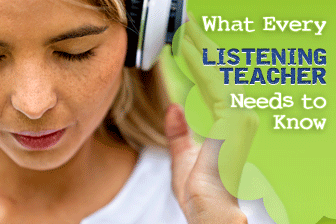What Every Listening Teacher Needs to Know


You need to know how to encourage your students to speak when they may feel too vulnerable to do so, you have to teach pronunciation and fluency, and you have to objectively evaluate a subject that is often highly subjective.
The articles below are compiled specifically for you, the speaking teacher, to make sure you know what every speaking teacher needs to know.
Part of teaching speaking is focusing in on pronunciation, but you do not have to limit yourself to what is in the textbook. Almost any topic can be used to teach pronunciation as long as the lesson has these three important pieces.
Vowels can be one of the most challenging aspects of English pronunciation for your students because the vowel sounds included in their native language may not include the all of the vowels used in English. When you need to focus on vowels in your speaking class, try these strategies with your students.
Rhythm and stress are an important part of speaking in any language. This article will take you through step by step as you teach your ESL students how to use appropriate stress in their English sentences.
Role-plays are a classic way for your students to use their language skills in a real setting. They will have to think fast and creatively use the vocabulary they already know to communicate with each other. These top 10 situations in which your students will use real speaking skills can be practiced in the speaking classroom to get your students ready.
While you are teaching pronunciation, stress and rhythm, why not bring some fun into the classroom? Chants and rhymes are a fun way to teach some important aspects of speaking. This article will give you some fun and creative ways of using chants to teach English.
Is what a person says really what he or she means? When students learn about the pragmatics of conversation, they may find that a word or phrase does not mean exactly what they think it means. This article discusses the how and why of teaching the real intention behind language and how it is used to get things done.
One challenge speaking teachers are often faced with is a multilevel class. It is a challenge since the same material might not be appropriate for every student’s abilities, but the reality is multilevel classes are all too common. With this strategy, all of your students will be engaged in the class discussion without feeling intimidated or pressured.
One of the advantages of teaching speaking is that you can do it almost anywhere. When the sun shines down and the fresh air of spring and summer beckons, you have the freedom to take your class outside where others would be too dependent on the white board. Teaching your students to use small talk is a real language skill that will come in handy in many different situations with native speakers. Get your students comfortable with it now and they will be ready when the time comes to use it.
Teaching formal pronunciation is one thing. Sometimes teaching how real people speak is something else entirely. As speaking teachers, we need to make our students comfortable with using and recognizing natural pronunciation patterns in English. This article will take you through the steps in teaching reductions to your students, which will give them more fluent and natural sounding speech.
Do you ever wonder how a subject as subjective as speaking can be graded empirically? This article points out how a speaking teacher can use concrete methods for evaluating his or her students’ speaking abilities.
Since speaking class is all about using English in real life situations, shouldn’t your testing methods be about the same thing? This article walks you through each step of creating a communicative assessment for your students, one that will test their real language abilities in real life situations.
With the basics in place, you can introduce any content material that inspires you and your students, and as you encourage learners from all over the world to use the language that they know, you and they will find that there is nothing quite like a great speaking class!